Exploring the Uses and Benefits of Crystals
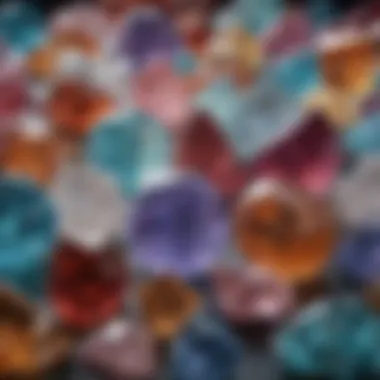
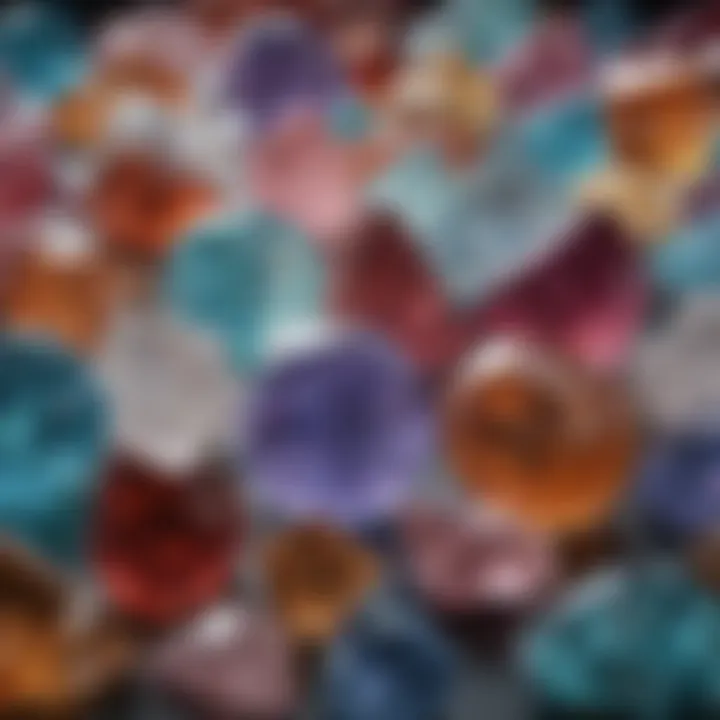
Intro
Crystals have fascinated humankind for centuries. These beautifully formed minerals are more than just visually appealing items; they are steeped in tradition, culture, and countless uses across various fields. From ancient civilizations to modern-day practices, the allure of crystals extends far beyond decoration. This article aims to peel back the layers on how these natural wonders serve multiple purposes in our lives today.
Embarking on this journey, we will explore numerous dimensions of crystals, covering their historical roots, key properties, and the transformative roles they play in healing, protection, and personal empowerment. Our detailed chart will provide an at-a-glance reference for those seeking to understand the various applications of crystals comprehensively.
Gemstone Overview
Definition and Origins
At its core, a crystal is a solid material whose constituent atoms are arranged in an orderly repeating pattern. This unique structure gives each crystal its distinctive characteristics, including its shape, color, and physical properties. The origins of crystals can be traced back to geological processes, with many being formed deep within the Earth’s crust over millions of years, often in extreme conditions of heat and pressure.
Some well-known crystals like quartz and amethyst can be found globally, while others, like Tanzanite, are more localized. In each case, the unique environment in which a crystal forms contributes to its individual identity.
Historical Significance
Historically, crystals have held significant value across cultures. For example, the ancient Egyptians used lapis lazuli for both decorative purposes and in jewelry, believing it possessed protective qualities. The Greeks, on the other hand, linked certain stones to deities, often employing them in ritualistic practices. Crystals have also played a prominent role in traditional healing systems, such as Ayurveda, which emphasizes the use of gemstones for harmonizing physical and emotional well-being.
Moreover, in the context of metaphysical practices, many have come to associate these stones with various energies. Each crystal is thought to resonate with specific vibrations conducive to healing, making them an integral part of both spiritual and holistic health approaches.
"Crystals have been the backbone of ancient practices, grounding human connection with nature and offering avenues for healing."
Gemstone Properties
Hardness and Durability
The properties of crystals vary widely, but two notable factors are hardness and durability. The Mohs scale, a standard guide for measuring mineral hardness, helps enthusiasts gauge how resistant a gemstone is to scratching. For instance, diamonds top this scale, while soft stones like talc sit at the bottom. Understanding the hardness of gemstones is crucial for collectors and jewelry makers alike.
- Diamond: 10 (extremely hard, suited for engagement rings)
- Emerald: 7.5-8 (beautiful but requires care due to inclusions)
- Opal: 5.5-6.5 (requires special handling to maintain its beauty)
Color and Clarity
Another vital aspect of gemstones is their color and clarity. The appearance of a crystal can be influenced by various factors, including impurities, light refraction, and surface characteristics. These elements contribute to what is often a gemstone’s greatest allure. Many collectors prioritize clarity to enhance the beauty of jewelry pieces, while others may be drawn to the vivid colors present in crystals like tourmaline or sapphire.
In summary, the journey into the world of crystals delves into their surface characteristics, historical narratives, and multifaceted properties. Each crystal tells a story, offering insights into its origins and potential uses. As we move forward in this article, we will examine how these precious materials can be harnessed in everyday practice, promoting not just personal empowerment but also a deeper connection to the Earth itself.
Preamble to Crystal Uses
The world of crystals goes beyond their aesthetic value; they hold a rich tapestry of uses and meanings intertwined with history, culture, and personal practice. Understanding crystals is crucial not just for enthusiasts but for anyone interested in their myriad applications. This section introduces the essence of crystals, their fundamental properties, and the ranges of uses they offer. It encompasses physical, emotional, and spiritual applications, which are essential in creating a holistic approach to incorporating crystals into everyday life.
Crystals, with their dazzling colors and intricate formations, are often seen as mere ornaments. However, their importance spans several dimensions, particularly in the realms of healing, protection, and empowerment. Knowledge of crystal uses allows individuals to tap into their potential, enhancing well-being and fostering personal growth.
Defining Crystals
At their core, crystals are solid materials whose constituents are arranged in an orderly repeating pattern. This specific arrangement gives them unique properties and appearances. Think of them as nature's own artwork, manifesting from the mineral kingdom or forming through processes like cooling of molten rock or evaporation of saline water. The formation of quartz or amethyst—each crystal brings distinct vibrations and meanings.
Crystals can be categorized into three main types: mineral, organic, and synthetic. Mineral crystals, like quartz and calcite, arise from geological processes. Organic crystals, such as amber and jet, originate from once-living organisms. Finally, synthetic crystals, for example, cubic zirconia, are man-made, crafted to mimic natural stones. Each type carries different attributes and potential uses, enriching the spectrum of crystal applications.
Historical Significance of Crystals
Throughout history, crystals have been celebrated across many cultures. In ancient Egypt, for instance, lapis lazuli and turquoise were not only ornamentation but also thought to have powerful protective properties. They would be placed in tombs to safeguard the souls of the deceased in the afterlife. Similarly, the Romans were known to wear amulets featuring gemstones like onyx or carnelian, believing these stones provided invulnerability in battle.
Across the globe in Asia, belief systems such as Feng Shui incorporate crystals into spatial arrangements to enhance energy flow in homes and workplaces. The holistic nature of crystals resonates through various practices, from balancing energies to attracting abundance.
"Crystals are nature's memory and their energy fields can help harmonize our environmental energy."
Furthermore, Indian Ayurvedic traditions utilize crystals as part of holistic healing systems, connecting the physical body with spiritual well-being. Modern times haven't altered this trajectory; the revival of interest in holistic health has seen crystals experience a renaissance. They now play prominent roles in wellness cultures, meditation groups, and personal empowerment workshops. The contemplation of crystals carries a sense of legacy, traversing time and space, proving their significance remains as relevant today as it was in ancient times.
Understanding these elements gives insight into how crystal uses have evolved and diversified, ensuring their continued relevance in contemporary practices. Whether drawn to their beauty or their purported healing properties, crystals remain cherished companions on personal journeys.
Types of Crystals and Their Unique Properties
Understanding the different types of crystals and their unique properties is crucial for anyone interested in their various applications. The world of crystals is vast, comprising mineral, organic, and synthetic varieties, each with distinct traits that lend themselves to unique uses. This knowledge not only enhances one's appreciation but also aids in making informed choices when selecting crystals for specific purposes. Each type of crystal carries its own story and energy, making the topic both fascinating and educational.
Mineral Crystals
Mineral crystals are perhaps the most recognized and widely collected category. Formed through natural geological processes over thousands of years, these crystals boast incredible diversity in color, shape, and composition. Some well-known examples include quartz, amethyst, and citrine. Each of these has its own vibrational frequency that can be harnessed for various applications.
Mineral crystals are often sought after for their purported healing properties. For instance, clear quartz is deemed a master healer, thought to amplify energy and thought. Many believe that these crystals absorb energies from their surroundings and can be used to influence physical and emotional healing. Here are a few noteworthy characteristics of mineral crystals:
- Natural Formation: Created through geological processes such as cooling magma or evaporating seawater.
- Variety of Uses: Utilized in jewelry, decor, and holistic practices.
- Energy Vibration: Each type possesses a unique energy that can affect the user differently.
In addition to their beauty and relevance in healing practices, mineral crystals often serve as a reminder of Earth's natural wonders, connecting us to the slow yet profound processes that shape our planet.
Organic Crystals
Organic crystals differ significantly from their mineral counterparts. This category includes substances that are biologically derived, such as pearls, amber, and coral. Formed from living organisms and composed of organic materials, these crystals carry a different energy and meaning. For example, amber, formed from tree resin, is often associated with warmth and healing properties.
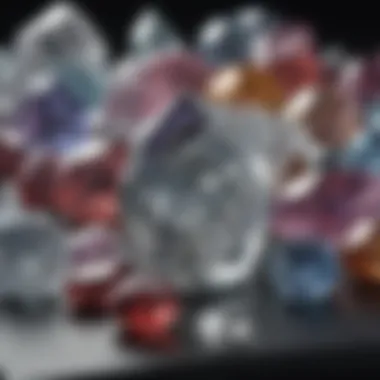
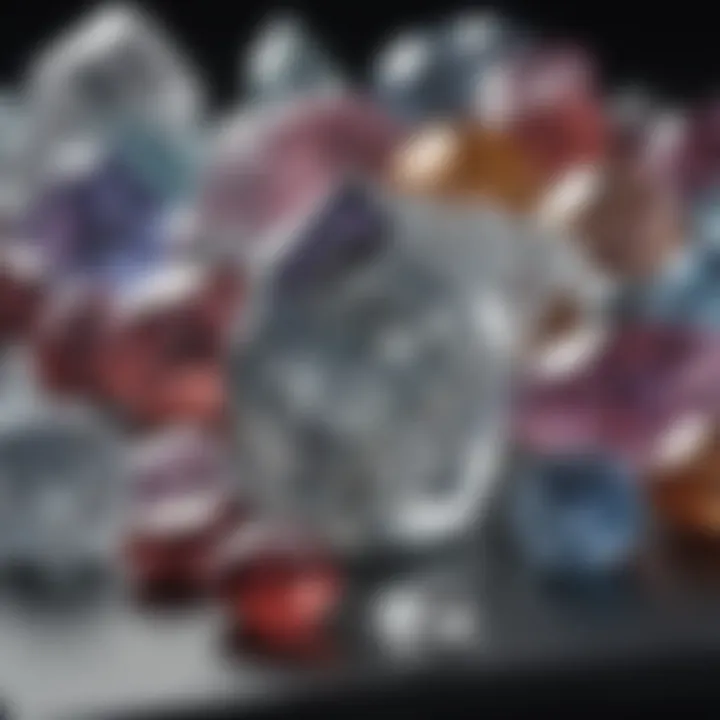
Organic crystals can be used in various settings, including:
- Jewelry Design: Their unique forms and colors make them attractive options for wearable art.
- Cultural Artifacts: Many hold historical and cultural significance that adds depth to their use in various practices.
One key point to remember is that organic crystals often resonate with qualities related to growth and transformation, aligning them closely with personal development and holistic healing approaches.
Synthetic Crystals
On the other end of the spectrum, we find synthetic crystals. Developed through human ingenuity, these crystals do not occur naturally. Their creation involves replicating the conditions under which natural crystals form, often to enhance specific qualities or to introduce new features. Cubic zirconia, for example, mimics the appearance of diamonds but comes at a fraction of the cost. Moreover, synthetic varieties are often created to ensure purity and durability, making them popular in various applications from jewelry to industrial uses.
Synthetic crystals offer distinct advantages:
- Controlled Properties: Their features can be precisely engineered to meet specific requirements.
- Cost-Effective: Generally less expensive compared to natural crystals, making them accessible for broader use.
- Stability: May withstand different environmental conditions better than some natural crystals.
While some may argue that synthetic crystals lack the ‘soul’ of natural stones, they possess their own charm and practical applications that cannot be overlooked. This category exemplifies the merging of nature and technology, showcasing how both can coexist to meet human needs.
"The essence of crystals lies not only in their beauty but also in their ability to transcend time and application."
Through understanding the diverse types of crystals—mineral, organic, and synthetic—individuals can appreciate their unique properties and make informed decisions tailored to their individual needs. Whether one seeks healing, aesthetic pleasure, or simply a connection to nature, there is a crystal suited for every purpose.
Healing Uses of Crystals
The exploration of healing uses of crystals holds a significant position within this article. Crystals have long been admired not just for their beauty, but for their purported healing attributes. People turn to these natural wonders for a variety of reasons, spanning physical ailments to emotional support. The holistic principles connecting crystals to well-being underline the invitation for both the curious and the knowledgeable to delve deeper into their applications. The benefits associated with crystal healing are seen as alternative approaches for self-care, enhancing vitality, and overall balance in life.
Physical Healing Applications
Physical healing through crystals is often a hot topic among enthusiasts. Many believe that the vibrational frequencies emitted by crystals can influence bodily functions and energies. For instance, amethyst is touted for its calming properties, making it popular for alleviating headaches and promoting sleep. Similarly, rose quartz is known for its role in improving circulation and aiding in the physical heart’s well-being.
Considerations when utilizing crystals for physical healing involve understanding one’s individual circumstances. Not all crystals work the same for every person. Here’s a brief list of some crystals commonly associated with physical healing:
- Clear Quartz: Often called the “master healer,” it is believed to amplify energy and thought.
- Citrine: Linked to improving digestion and enhancing metabolism.
- Black Tourmaline: Considered to provide protection against environmental toxins.
It's crucial those exploring these methods do so hand-in-hand with licensed medical advice. Crystals should complement traditional treatments rather than replace them.
Emotional Healing Practices
When turning the focus onto emotional healing, crystals become invaluable allies. Many people use these gems to help navigate the murky waters of feelings and mental states. Lepidolite, rich in lithium, is often referenced for its soothing qualities that can help ease anxiety and stress. Another example is carnelian, which is associated with boosting motivation and overcoming fear.
The emotional benefits can be felt in various settings, whether it’s through meditation, or carrying crystals in one’s pocket. Here are some crystals commonly thought to aid emotional healing:
- Blue Lace Agate: Known for its calming effect and ability to facilitate effective communication.
- Smoky Quartz: Used to help release negative emotions and promote positive energy.
- Howlite: Often sought for its tranquil energy, encouraging patience and calm.
Practitioners should aim for personal resonance with these stones as their impact can vary greatly from person to person.
Spiritual Healing Techniques
Spiritual healing with crystals often intertwines with practices like meditation or chakra alignment. Crystals like sodalite and lapis lazuli are believed to enhance spiritual growth and awareness. By meditating with such stones, it’s thought one can clear mental clutter and connect with deeper aspects of oneself.
Moreover, spiritual practitioners often employ crystals in rituals or healing spaces. Here’s a curated list of crystals favored for spiritual healing:
- Clear Quartz: Believed to enhance spiritual clarity and connect with higher realms.
- Amethyst: Known as a stone of spiritual protection, it assists in opening the crown chakra.
- Moonstone: Often associated with intuition and emotional balance, enhancing spiritual insight.
"Using crystals promotes a sense of tranquility by inviting energies conducive to emotional and spiritual well-being."
Protective Uses of Crystals
The protective uses of crystals represent a fascinating and vital aspect of their overall application. These stones are not just visually appealing but also claimed to offer a sense of security and grounding for individuals who believe in their innate abilities. Crystals are thought to form a barrier against negative energies, be they environmental, emotional, or psychic in nature. This section examines how crystals can serve as protective tools and the considerations to keep in mind when incorporating them into one's life.
Energy Protection
Energy protection refers to the capability of certain crystals to shield individuals from negative energy. In a world where stress and anxiety often feel like a constant presence, many seek ways to foster a positive atmosphere around themselves. Crystals such as Black Tourmaline, Obsidian, and Hematite are frequently mentioned in discussions about energy protection. These stones are believed to absorb and repel unfavorable energies, creating a more balanced environment.
Here are some key benefits of using crystals for energy protection:
- Shielding against negativity: Crystals like Black Tourmaline are often used to block out negative forces, making them excellent companions for those in tumultuous environments.
- Promoting emotional stability: By creating a protective shield, these stones can help individuals maintain emotional equilibrium, thereby improving overall mental health.
- Enhancing personal space: Carrying or placing protective crystals in one's surroundings is said to promote a sense of peace and safety at home or work.
To integrate energy-protective crystals into daily practice, consider placing these stones in key areas, like your workspace or bedroom, where stressors tend to accumulate. In holding these energies close, practitioners claim they feel more secure and less affected by external disturbances.
Psychic Protection
Psychic protection delves into a more specific realm where individuals seek to guard against unwanted psychic influences and spiritual intrusions. This use of crystals can be particularly appealing for those who explore metaphysical practices or find themselves sensitive to the energies around them. Crystals like Amethyst, Clear Quartz, and Selenite are extremely popular in the pursuit of psychic shielding.
The advantages of employing crystals for psychic protection include:
- Strengthening intuition: Many believe that protective crystals can help enhance one's intuitive capacities, allowing individuals to better navigate and understand the energies that surround them.
- Clearing vibrant energies: Stones such as Selenite are thought to have cleansing properties, which might clear negative energies from a person's aura.
- Supporting spiritual defense: Protective crystals are often believed to create a barrier around the practitioner, warding off harmful entities or thoughts that may intrude.
To engage with psychic protection, it can be beneficial to create a small altar or space dedicated to these crystals, inviting a sense of sacredness and intention into the practice. Meditating with these stones can further align one's energy, opening pathways to heightened awareness while providing essential protection.
"Crystals may serve not only as adornments but as powerful tools in the arena of personal and psychic protection, affording individuals a sense of safety in both emotional and spiritual realms."
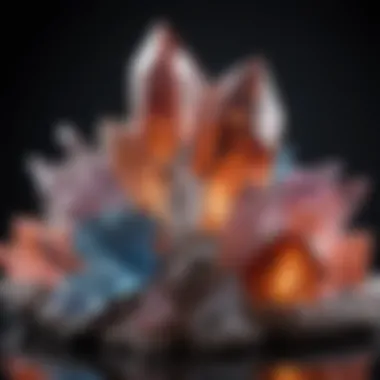

As we navigate our lives with complexities and energies that can be overwhelming, understanding the protective uses of crystals allows gemstone enthusiasts to harness their properties for safeguarding and empowerment.
Crystals in Meditation and Mindfulness
Meditation and mindfulness practices have gained significant traction in recent years as a means to promote mental well-being, focus, and inner peace. In this context, crystals serve as powerful tools that can enhance these practices profoundly. They are believed to contain unique vibrations and energies that can resonate with the mind and body, making them more than mere decorative pieces. Understanding how to choose and incorporate crystals into meditation is essential for maximizing their benefits.
Choosing Crystals for Meditation
When selecting crystals for meditation, the first step is to understand the intended purpose. Each crystal has its own properties, often associated with specific energies. Here are some popular choices:
- Amethyst: Known for its calming qualities, it supports peaceful meditation experiences and helps to quiet the mind.
- Clear Quartz: Often regarded as a master healer, it amplifies the energies of other crystals and aids in concentration.
- Rose Quartz: Renowned for its loving energies, it fosters compassion and emotional healing, ideal for heart-centered meditative practices.
- Black Tourmaline: This crystal is excellent for grounding and protection, making it suitable for those who feel overwhelmed.
When picking a crystal, it’s essential to trust one’s intuition. Sometimes, the crystal that catches your eye or resonates with your energy might be just what you need. Additionally, considering the physical size and shape of the stones can also impact the experience; smaller, palm-sized crystals are often easier to hold during meditation.
Techniques for Incorporating Crystals in Practice
Incorporating crystals into meditation can be as straightforward or as elaborate as one desires. Here are several techniques to consider:
- Holding the Crystal: Grasp the chosen crystal in your palm or place it on your lap while you meditate. This direct contact can help channel its energy into your being.
- Crystal Grid: Arranging multiple crystals in a specific pattern can create a strong energy field. This method is often used to focus intentions on specific outcomes, such as healing or protection.
- Placement on Specific Chakras: Different crystals can be placed on various energy centers of the body. For instance, placing lapis lazuli on the throat chakra during meditation might aid in enhancing communication.
- Visualisation Techniques: While meditating, visualize the crystal’s energy filling your aura or the space around you. This practice might help one connect deeper with the energy of the crystal, enhancing the meditative experience.
- Infusing Water or Food: It’s believed that crystals can infuse water with their energy when placed nearby. Consuming this water or using it in rituals might deepen one’s connection to the crystals.
"True peace comes from within. With the right crystals, your meditation can take on transformative qualities, leaving you refreshed and re-energized."
Each method offers unique advantages, depending on personal preferences and experiences. Ultimately, integrating crystals into meditation can lead to richer, more profound journeys toward mindfulness and tranquility.
The Role of Crystals in Personal Empowerment
Crystals have long captivated human imagination, serving not only as aesthetic objects but also as tools for individuals seeking to enhance their own personal power. In the framework of this article, we examine how these natural treasures can influence self-perception and personal growth. The role of crystals in personal empowerment centers around their potential to facilitate a heightened sense of confidence, clarity, and intentionality.
By engaging with the unique vibrations of different crystals, users can tap into their inherent strengths. This journey involves recognizing the deep connection between one’s emotional state and the properties of these stones. The energy emitted by a crystal can affirm one's aspirations and promote a shift in mindset towards a more empowered self.
Enhancing Confidence and Self-Esteem
When it comes to the intersection of crystals and personal empowerment, a prevalent aspect is enhancing confidence and self-esteem. Certain crystals are reputed to provide support in these areas, acting like a gentle nudge to help individuals find their footing.
Some popular crystals for boosting confidence include:
- Citrine: Often associated with abundance and positivity, it radiates a joyful energy that can uplift spirits and instill confidence.
- Tiger's Eye: This stone is known for its grounding properties; it helps in overcoming fear and indecisiveness, paving the way for assertiveness.
- Rose Quartz: Primarily recognized for its nurturing capabilities, it encourages self-love, a critical pillar for building robust self-esteem.
Crystals such as Citrine can inspire not just a fleeting sense of confidence but a deeper realization of personal worth. It’s been said that wearing a piece of Tiger's Eye can create a protective energy shield, allowing the wearer to step forward without the nagging voice of self-doubt.
"Confidence is not something you’re born with; it’s nurtured and reflected in how you carry yourself amidst challenges. Crystals help illuminate that path."
Setting Intentions with Crystals
Intention-setting is a powerful practice that pairs beautifully with the use of crystals. This process involves focusing one’s energy and purpose on specific goals or desires, and certain crystals can enhance this focus by resonating with the user's aspirations. Setting intentions with crystals involves a few thoughtful steps.
- Choose the Right Crystal: Each crystal comes with its own distinct energy. For instance, Amethyst can aid in clarity of thought, while Aventurine might be more suited for attracting luck and opportunity.
- Create a Clear Intention: Take time to reflect on what you wish to achieve. Be as specific as possible. Writing this intention down can help solidify it in your mind.
- Engage with the Crystal: Hold the crystal in your hand or place it in front of you as you visualize your intention. This connection helps to charge the crystal with your energy.
- Regularly Revisit the Intention: Check in with yourself. Hold your crystal and reaffirm your goals.
Establishing intentions with crystals transforms vague ambitions into tangible outcomes. This intentional practice resonates deeply with the notion of personal empowerment, allowing individuals to not only dream but actively participate in cultivating their desired reality.
Through crystals, empowerment becomes a shared journey of self-discovery—a way to align oneself with personal strengths and aspirations.
Cultural Significance of Crystals
Crystals have long woven their way through the tapestry of human history, reflecting the beliefs, practices, and societal norms of diverse civilizations. Their meanings, implications, and applications vary widely, yet they all point to the fundamental human fascination with the natural world. This section explores how crystals hold a significant place in cultural contexts, providing insights into not just their beauty but also their roles in rituals, traditions, and artistry. The fascination with these geological wonders speaks to a deeper yearning for connection—whether to oneself, to others, or to the universe.
Crystals in Ancient Civilizations
In ancient times, the utilization of crystals mapped out various purposes far beyond their aesthetic appeal. They were revered not only for their physical beauty but also for their purported metaphysical properties.
- Egyptians: Ancient Egyptians utilized a myriad of crystals in their spiritual practices. Lapis Lazuli and turquoise were prized for their associations with protection and wisdom. They believed these stones could bridge the physical realm with the divine, often embedding them in tombs as a guardian against evil spirits.
- Greeks and Romans: The Greeks and Romans regarded Amethyst as a protective talisman, claiming that it could prevent intoxication. This stone became a symbol of sobriety and divine protection, often worn as jewelry in the hopes of acquiring its beneficial qualities.
- Mesoamerican Cultures: In Aztec and Maya civilizations, obsidian was utilized for both tools and ceremonial purposes. Its sharpness made it practical for construction and weaponry, while its ability to create polished surfaces turned it into a medium for mirrors—thought to allow glimpses into the spiritual realm.
These examples underscore a broader theme seen in many cultures: crystals were not just ornamental but were integral to belief systems. The roles they played held profound implications for life, death, and what lay beyond.
"Crystals are the echoes of the earth’s history, speaking the language of the ancients."
Modern Cultural Practices Involving Crystals
Fast forward to today, and the cultural significance of crystals has evolved but not diminished. Modern practices surrounding crystals reflect a blend of ancient wisdom filtered through contemporary interpretations. Here are several noteworthy aspects of how crystals continue to fit into the fabric of modern society:
- Spirituality and New Age Movements: Many contemporary movements advocate for the spiritual usage of crystals, suggesting their capacity to promote healing and balance energy. Amethyst, quartz, and selenite are often employed in meditation and energy cleansing practices.
- Home Decor: Crystals have found a comfortable niche in home decor and aesthetics. Pieces such as geodes and polished stones serve decorative purposes while also promoting positive energy in living spaces. The trend of crystal-infused furniture and art displays testifies to their continued impact on design.
- Workshops and Community Groups: Interest in crystals has led to the formation of communities and workshops dedicated to crystal education and application. Groups gather to share experiences, explore crystal properties, and discuss their applications in healing practices. Social media platforms like Facebook and Reddit have become hubs for these discussions, connecting enthusiasts across the globe.
The ongoing fascination with crystals in modern culture suggests that these geological formations continue to captivate imaginations and hearts. They serve as conduits for personal exploration, cultural identity, and connection to something greater than ourselves.
Scientific Perspective on Crystal Uses
The scientific exploration of crystals and their applications holds great importance in understanding both the mechanical and mystical properties of these natural formations. While many enthusiasts prize crystals for their aesthetic properties or for their supposed healing powers, those involved in geology and material science focus on the structural, chemical, and physical characteristics intrinsic to each type of crystal. By casting a lens of scrutiny over this topic, we can discern the psycho-physical bridge that crystals purportedly establish, leading to a better understanding of their potential uses and limitations.
Crystals are not just beautiful; they have distinct properties that can be harnessed for various practical applications. For instance, their crystalline structures can make them excellent conductors of energy, useful in technology from circuit boards to radios. These properties can also extend to alternative healing practices where certain kinds of crystals are said to facilitate better energy flow within the human body. The act of engaging with crystals, therefore, can offer a union of creativity, science, and personal development, making it an interesting topic for exploration.
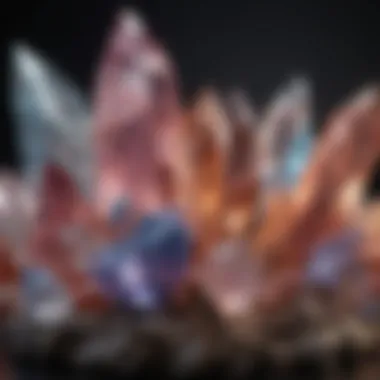

Research on Crystal Properties
Research surrounding the properties of crystals dives deep into fields like crystallography and solid-state physics. Crystallography studies the arrangement and organization of atoms within a crystalline structure, revealing shapes, patterns, and features that lead to their diverse applications.
Some key aspects include:
- Unique Structures: Each crystal type has a specific lattice structure, influencing its electrical and optical properties.
- Vibrational Frequencies: Different crystals resonate at unique frequencies, leading some practitioners to believe they can promote specific healing effects.
- Energy Flow: Studies in both traditional science and alternative medicine suggest crystals can influence subtle energy fields around individuals, although empirical validation remains scarce.
Most notably, the work of scientists in material science has begun to uncover how certain crystals—like quartz—can have transformative powers when subjected to pressure, generating an electric charge. This property is known as piezoelectricity, enabling its use in numerous electronic devices.
Skepticism and Criticism of Crystal Healing
Despite the scientific findings, skepticism persists regarding the efficacy of crystals in healing practices. While proponents claim they offer therapeutic benefits, skeptics argue that any perceived improvement in well-being often stems from the placebo effect rather than the crystals themselves.
Some common points of criticism include:
- Lack of Empirical Evidence: Many claims regarding crystals remain anecdotal rather than scientifically validated.
- Cognitive Biases: Confirmation bias can lead individuals to perceive benefits from crystals that may not be directly attributable to their presence or use.
- Over-Simplification of Complex Issues: Health conditions often require comprehensive treatment protocols that crystals cannot substitute for, leading critics to accuse promoters of misrepresenting their potential.
"Crystals serve as a mirror for our intentions. However, it is essential to approach their uses from a place of understanding, integrating both science and belief for a spectrum of experience."
In the world of crystals, where ancient wisdom intersects with modern science, the battle between validation and skepticism continues. Engaging with this ongoing dialogue can deepen our appreciation for these natural wonders while grounding our expectations in reality. As the field evolves and empirical research unfolds, fresh insights may yet illuminate the potential of crystals beyond what is known today.
Practical Applications of Crystals
Understanding the practical applications of crystals transcends mere aesthetics or spiritual beliefs. Crystals have found their way into our daily lives in various forms, each contributing in unique ways. The significance of integrating crystals into everyday routines and spaces can't be understated. They do not only serve as decorative items or collectibles; rather, they can enhance our well-being, foster a sense of calm, and serve as tools for empowerment.
Using Crystals in Everyday Life
Incorporating crystals in daily life can seem a bit esoteric at first, but it can be much simpler. The world we live in often feeds us a whirlwind of stress and negativity. Crystals, like citrine or amethyst, can act as little beacons of positivity. Their energetic vibrations can create a more favorable environment for personal growth and tranquility.
- Practical Uses: Consider placing a rose quartz on your desk. It can emit loving energy and soften the hard edges of a busy work environment.
- Mindfulness Practices: Some people carry crystals in their pockets or bags, using them as grounding tools during stressful moments.
- Boosting Intention: Setting intentions with crystals, such as carrying a black tourmaline for protection during challenging days, is also a common practice. It serves as a reminder to stay centered and focused on personal goals.
"Crystals provide not just beauty but also support in navigating the complexities of modern life."
Incorporating Crystals in Home Decor
Crystals can elevate the aesthetic of any space, but their significance goes deeper than mere decoration. When integrated thoughtfully into home decor, they can contribute to the overall energy of your environment. Each type of crystal has unique properties that can influence ambiance and mood.
- Selection: Choosing the right crystals for decor involves understanding what you want to achieve. For instance, placing a calming blue calcite in a bedroom can enhance relaxation and promote peaceful sleep.
- Display Methods: Crystals can be displayed openly in bowls, on shelves, or as part of a centerpiece. Grouping them by color or type can create a visually appealing look. Consider leaving a few amethyst clusters on a coffee table for guests to enjoy.
- Feng Shui Considerations: In Feng Shui, specific crystals are recommended for different areas of the home. For example, using citrine in the wealth corner of your home may invite abundance.
Creating a Crystal Uses Chart
When we dive into the world of crystals, it’s easy to feel overwhelmed by the plethora of options and uses. That's where a well-organized crystal uses chart comes into play. This chart acts like a roadmap for crystal enthusiasts, collectors, and even those dabbling in healing practices. By presenting information in a structured manner, it allows individuals to quickly find the specific information they seek, whether for healing, protection, or personal empowerment. A thoughtfully created chart serves as a handy reference and simplifies the learning process.
Components of an Effective Uses Chart
A crystal uses chart should not be just a collection of names and properties. It ought to be a comprehensive tool that highlights the essential elements of each crystal. Here are the vital components that should be included:
- Crystal Name: The name of the crystal must be clear, helping users easily identify what they’re looking for.
- Properties: Each crystal possesses unique properties. Summarizing these properties offers immediate insight into what the crystal can do. For example, amethyst is not just pretty; it's recognized for promoting tranquility.
- Uses: Highlighting practical applications is crucial. How can each crystal be used? Whether for healing physical ailments or enhancing spiritual practices, outlining this can guide users effectively.
- Tip or Advice: Including tips such as "use rose quartz in meditation for self-love" adds a practical dimension, giving guidance on maximizing the crystal's potential.
- Visuals: If possible, adding a small image of the crystal can be helpful. A visual can trigger recognition and enhance the overall appeal of the chart.
This structured approach not only enhances clarity but encourages enthusiasts to explore deeper into the properties of each crystal. When information is organized logically, it enhances user experience, making the chart a dynamic resource.
Recommended Crystals for Specific Uses
Creating a reliable crystal uses chart is incomplete without recommending specific crystals for various applications. Here’s a look at a few notable crystals and their purposes:
- Amethyst: Known for its calming energy, it's often recommended for reducing stress and enhancing intuition. Many meditation practitioners swear by its benefits.
- Citrine: This vibrant yellow crystal is touted for its ability to attract prosperity. It's useful for setting financial intentions and manifesting abundance.
- Black Tourmaline: Widely recognized for its protective qualities, this crystal is excellent for warding off negative energies, making it a must-have for anyone in challenging environments.
- Clear Quartz: Dubbed the master healer, clear quartz is incredibly versatile. It amplifies energy and is said to enhance the properties of other crystals when used together.
- Rose Quartz: The stone of love, it supports emotional healing and helps cultivate self-love. It’s recommended for anyone looking to open their heart to both themselves and others.
These recommendations serve as a solid foundation for those looking to incorporate crystals into their lives for specific purposes. They allow enthusiasts to connect the dots between crystal properties and their uses, making the journey into the crystal world less daunting and far more rewarding.
A well-crafted crystal uses chart is like having a treasure map; it guides you to the gems that hold the potential for transformation.
Closure and Future Directions
As we draw our exploration of crystal uses to a close, it becomes clear that the topic of crystals transcends simple aesthetics or mere fascination. The significance of understanding their multifaceted applications cannot be overstated, especially in a world increasingly leaning towards holistic healing and wellness practices. Through this article, we have emphasized the various roles that crystals play—from healing physical afflictions to providing emotional support and enhancing personal empowerment.
The future direction of crystal exploration appears promising. As more individuals engage in practices surrounding crystals, ongoing research and experiential evidence will likely unearth deeper insights into their benefits. Moreover, crystal enthusiasts, collectors, and practitioners are actively shaping the narrative surrounding these gemstones, fostering communities that share knowledge and experience.
Key elements to consider moving forward include:
- Community Engagement: The grassroots sharing of experiences regarding crystal uses can help build a comprehensive understanding.
- Scientific Inquiry: Continued research into the properties and effects of crystals is vital. Collaborative efforts between scientists and practitioners may yield new revelations.
- Educational Initiatives: Workshops, online courses, and publications can enrich knowledge about crystals for both newcomers and seasoned aficionados.
In sum, the path ahead for crystal exploration encourages curiosity and open-mindedness, suggesting that the comprehensive chart created in this article is merely the tip of the iceberg. Rather, it serves as an initiation into the broader universe of crystals, punctuated by both ancient insights and contemporary practices, all of which await deeper understanding.
The Ongoing Exploration of Crystals
The journey into the world of crystals is far from over. Each day, practitioners and scholars alike deepen their understanding. New applications for these natural wonders are continually discovered, ranging from their use in technology to their role in alternative medicine. The collective belief within the crystal community seems to be that crystals harbor unique energies, and such convictions drive a profound exploration across various fields.
Communities online, like those found on Reddit, have become platforms for sharing personal narratives about the improvements and alterations individuals have encountered through their interactions with crystals. This ongoing exploration not only strengthens the bond among enthusiasts but also empowers them to harness the potentials of their preferred gemstones fully.
Potential Innovations in Crystal Applications
Looking ahead, there are several intriguing potential innovations in how crystals may be utilized. As society grows more aware of wellness and holistic practices, the integration of crystal technology presents exciting possibilities. Some hihlights include:
- Crystals and Technology: Researchers are experimenting with the use of crystals in electronics, investigating properties like piezoelectricity to enhance devices.
- Crystals in Architecture: Innovative designers are beginning to leverage the aesthetic and energetic properties of crystals in building materials, creating spaces that soothe the spirit.
- Personal Care Products: Yet another area garners attention with companies exploring infusions of crystals in skincare and health products, claiming various benefits.
Rounding up, embracing these potential innovations ensures that the intrigue around crystals will not wither. Instead, it may well flourish, inviting a more extensive narrative to evolve, where ancient wisdom meets modern scientific endeavor.



